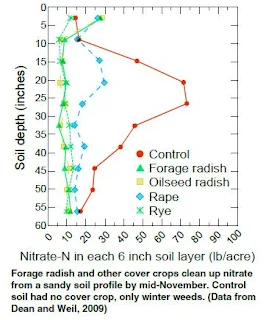Back in the 1980s and 1990s there was a huge amount of research into the use of winter rye (aka, cereal rye, rye grain) as a cover crop. Proponents of using rye claimed it had allopathic activity that reduced weed populations, depressed nematode populations, scavenged leaching nutrients and cured male pattern baldness.
Weed control: TRUE
Cereal rye produces several compounds in its plant tissues and releases root exudates that apparently inhibit germination and growth of weed seeds. These allelopathic effects, together with cereal rye's ability to smother other plants with cool weather growth, make it an ideal choice for weed control.
However, allelopathic compounds may suppress germination of small-seeded vegetable crops as well if they are planted shortly after the incorporation of cereal rye residue. Large-seeded crops and transplants rarely are affected. There is some evidence that the amount of allelopathic compounds in tillering plants is lower than in seedlings.
Depress Nematode Population: True
 |
| Most cultivars of rye tested were relatively inhospitable to Root Knot Nematodes as measured by RKN egg production |
 |
| Other cover crops like annual ryegrass may be even more effective at suppressing nematodes. |
Scavenge Leaching Nutrients: TRUE
Male Pattern Baldness: Unproven
Trials testing rye as a cure for male pattern baldness ran into difficulties in preparing a seed bed deep enough for reliable germination and resistance of women to green hair.


No comments:
Post a Comment
Readers who are willing to comment make this a better blog. Civil dialog is a valuable thing.